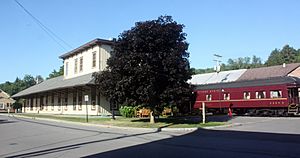Cooperstown and Charlotte Valley Railroad facts for kids

Former station in Cooperstown
|
|
| Overview | |
|---|---|
| Headquarters | Cooperstown, New York |
| Reporting mark | CACV |
| Locale | Otsego County, Upstate New York |
| Dates of operation | 1869– |
| Predecessor | Cooperstown and Susquehanna R. R., Co. |
| Technical | |
| Track gauge | 4 ft 8 1⁄2 in (1,435 mm) |
| Previous gauge | 6 ft (1,829 mm) |
| Length | 16 miles (26 km) |
The Cooperstown and Charlotte Valley Railroad Company (CACV) is a special heritage railroad in New York State. It's like a living museum where you can ride old trains! The Leatherstocking Chapter of the National Railway Historical Society (NRHS) has been running it since 1996.
Contents
History of the Cooperstown Railroad
The idea for a railroad in Cooperstown started in 1865. It was called the Cooperstown and Susquehanna Valley R.R. Company (C&SVRR). The goal was to build a railroad from Cooperstown to Colliersville. This would connect with another big railroad, the Albany and Susquehanna Rail Road.
Work on the line began in February 1868. The very first train ran on July 14, 1869. This railroad used a "broad gauge" track, which means the rails were 6 feet apart. This was wider than most tracks. On May 28, 1876, the entire 16-mile track was changed to a narrower size. This new size, 4 feet 8.5 inches, is called "standard gauge" and is used by most railroads today.
In 1880, the C&SVRR's enginehouse caught fire. This damaged two of their engines, named "The Otsego" and "Middlefield." It also destroyed a baggage car.
Expanding the Railroad Lines
The state allowed the C&SVRR to build two extensions. The first was in 1869, planned to go from Cooperstown to Richfield Springs. The second was in 1885, to extend the line further south along Charlotte Creek.
In 1888, a new company was formed: the Cooperstown and Charlotte Valley R.R. Co. (C&CVRR). This company also planned to build along Charlotte Creek.
Later, in February 1891, the West Davenport R. R. was started. It was meant to build a short line from the West Davenport depot. Just two months later, on April 13, 1891, the C&CVRR and the West Davenport R.R. joined together. Two days after that, the C&CVRR leased the C&SVRR. This meant the C&CVRR was now in charge of the original Cooperstown line.
People in Cooperstown wanted to connect their railroad to other major lines. They hoped to extend the C&CVRR eastward. Work began after a big snowstorm in 1888. By 1889, the track reached West Davenport, about 6 miles away. Builders also prepared the ground further along the valley.
In February 1890, the C&CV track reached Davenport Center. However, further work stopped. For many years, the track ended there. People who wanted to travel further had to use a stagecoach, like a horse-drawn bus, called a "Tally Ho."
In 1899, another railroad, the Ulster & Delaware, built a new line. It connected with the C&CV at West Davenport. They even shared a station. However, passenger train service from Cooperstown Junction stopped in 1903.
Delaware and Hudson Ownership
In 1903, the Delaware and Hudson Company (D&H) bought the C&CVRR. It became known as the "Cooperstown Branch." The D&H built a beautiful stone station in Cooperstown after they took over. This line was mainly used for moving goods, like freight. The D&H also built a turntable and a small place to fix locomotives in Cooperstown, but these were removed in the 1950s. The C&CV officially became part of the D&H in 1957.
In 1934, regular passenger train service on the C&CV ended. The last scheduled passenger train left Cooperstown on June 24.
The railroad continued to operate quietly, mostly carrying freight. But through the 1960s, less and less freight was carried on the line.
Delaware Otsego Ownership
In 1970, the D&H sold the remaining part of the C&CV line to the Delaware Otsego Corporation. This company brought back the old C&CV name.
Delaware Otsego built new places to fix locomotives in Milford. The company's main office was in the old Cooperstown station.
The CACV started running as a heritage railroad in the 1970s. They used an old steam locomotive for a while, and then diesel locomotives. People could ride these special trains on weekends until the mid-1980s.
By the early 1980s, freight traffic on the CACV was very low. Only a few cars of lumber or animal feed were moved each week.
The last freight train on the CACV ran in December 1987. After that, only a few trains moved equipment. In 1996, the Leatherstocking Chapter of the National Railway Historical Society bought the line.
Leatherstocking Chapter, NRHS Ownership
The Leatherstocking Railway Historical Society (part of the NRHS) bought the railroad line in 1996.
Volunteers worked hard to clear plants and fix the tracks. Because of their efforts, the line reopened in 1999 for special passenger trains. These trains run seasonally between Cooperstown and Milford. The railroad still uses the CACV name.
The southern part of the line connects to the Norfolk Southern Railway, which is a big freight railroad.
The CACV uses locomotives that used to belong to other railroads. They currently own two diesel locomotives from the Canadian National Railway. These locomotives are numbered 3051 and 3052. Unit 3051 has been painted in a special D&H design with CACV letters. Unit 3052 has been restored to its original Canadian National paint scheme. The museum also has some old Amtrak GG1 electric locomotives.
The CACV also owns and builds equipment to maintain the railway tracks.

